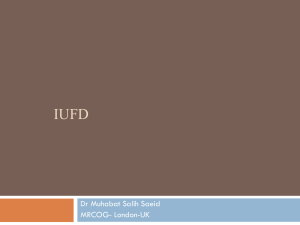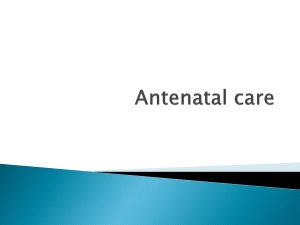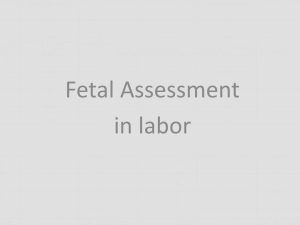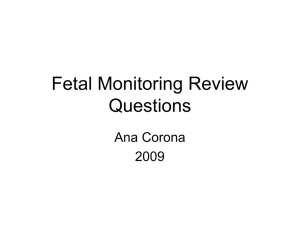C, D
advertisement
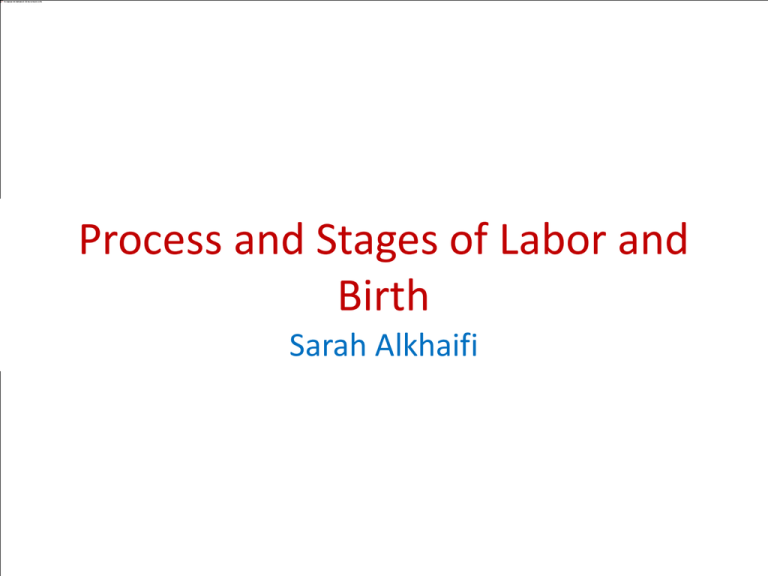
Process and Stages of Labor and Birth Sarah Alkhaifi Nursing/ Midwifery intervention during Second stage of labor Nursing management • Second stage of labor • Provide privacy (curtain, draping, information) • Encourage woman to share her feeling. • Teach woman prenatally about benefits of upright positions • During labor, encourage woman to change positions frequently; suggested positions include squatting, semi-recumbent, standing, and upright kneeling Positioning During labor Nursing management • Allow woman to rest until she feels an urge to push • Encourage spontaneous bearing down • Support, rather than direct, the woman’s involuntary pushing efforts • Discourage prolonged maternal breath holding • Monitor fetal heart (base line, variability, aceleration, deceleration) • Monitor the uterine contractions (intensity, duration) instruct the woman to push in according to the uterine contraction. Interpret the following CTG Nursing management • Assess the effectively of maternal pushing through comparing the bearing down with the fetal head descending. • place one hand (non dominant) on the fetal head to avoid rapid extension. • Support perineum during crowning with sterile pad. • Assess if there is indication for Episiotomy. Perennial support and control head extension As the fetal head pushes down, the perineum bulges. This sign indicates that birth is imminent. (Copyright © Barbara Proud.) Normal vaginal birth sequence. A: Early crowning. B: Late crowning. The fetal head is face down, in normal occiput anterior position. C, D: Extension of the fetal head (right occiput anterior position). E: Birth of the shoulders. F: Emergence of the rest of the fetal body, including the umbilical cord. Normal vaginal birth sequence. A: Early crowning. B: Late crowning. The fetal head is face down, in normal occiput anterior position. C, D: Extension of the fetal head (right occiput anterior position). E: Birth of the shoulders. F: Emergence of the rest of the fetal body, including the umbilical cord. Episiotomy. Nursing management • • • • • • • • • • • Check if umbilical cord present around the neck of baby. (loss, tight). Loss the umbilical cord in case the umbilical cord around the fetal neck. Let the fetus’s head to rotate (external rotation) Place your hand in each said of baby’s head and pull the fetal head downward to deliver the anterior shoulder ,then apply upward traction to deliver posterior shoulder. Deliver the rest of the newborn body, and place the fetal on the mother’s ABD. Inject 5 U of oxytocin IM after delivery of anterior shoulder. Cut and clamp umbilical cord. (technique). Perform APGAR assessment for the newborn. Perform immediate newborn care (see the lab) Collect umbilical cord blood (bilirubin ,blood culture, Blood gases, carbon dioxide, and pH levels, Blood sugar level, Blood type and Rh, CBC, Platelet count) What do you know about late VS early umbilical cord clamping? Normal vaginal birth sequence. A: Early crowning. B: Late crowning. The fetal head is face down, in normal occiput anterior position. C, D: Extension of the fetal head (right occiput anterior position). E: Birth of the shoulders. F: Emergence of the rest of the fetal body, including the umbilical cord. Normal vaginal birth sequence. A: Early crowning. B: Late crowning. The fetal head is face down, in normal occiput anterior position. C, D: Extension of the fetal head (right occiput anterior position). E: Birth of the shoulders. F: Emergence of the rest of the fetal body, including the umbilical cord. Normal vaginal birth sequence. A: Early crowning. B: Late crowning. The fetal head is face down, in normal occiput anterior position. C, D: Extension of the fetal head (right occiput anterior position). E: Birth of the shoulders. F: Emergence of the rest of the fetal body, including the umbilical cord Normal vaginal birth sequence. A: Early crowning. B: Late crowning. The fetal head is face down, in normal occiput anterior position. C, D: Extension of the fetal head (right occiput anterior position). E: Birth of the shoulders. F: Emergence of the rest of the fetal body, including the umbilical cord EBP APGAR Assessment Third stage of labor Third stage of labor • From complete fetal delivery till complete separation of the placenta. • Up to 30 minutes for placental separation • Mechanism of separation Firm uterine contraction Deceasing in the uterine surface area Bleeding and hematomah Third stage of labor • Signs of placental separation 1.Globular shaped uterus 2. Rise of fundus 3. Gush of blood 4. Lengthening of cord • Do not pull on cord !.... Why? Placental Delivery Placenta Delivery • After signs of placenta separation signs the mother may bear down. 1 • Controlled Cord Traction(CCT). 2 3 Placenta (fetal side) Placenta (Maternal side) Nursing Intervention During Third Stgae of Labor Fourth Stage of Labor Fourth Stage of Labor • • • • • • 1- 4 hrs after delivery Time of recovery After pains Hunger and thirst At risk for atony and hemorrhage Promote bonding and attachment Nursing Intervention During Fourth Stage of Labor References http://www.uptodate.com/contents/managementof-normal-labor-anddelivery?source=search_result&search=manageme nt+normal+labor&selectedTitle=1~150#H28






